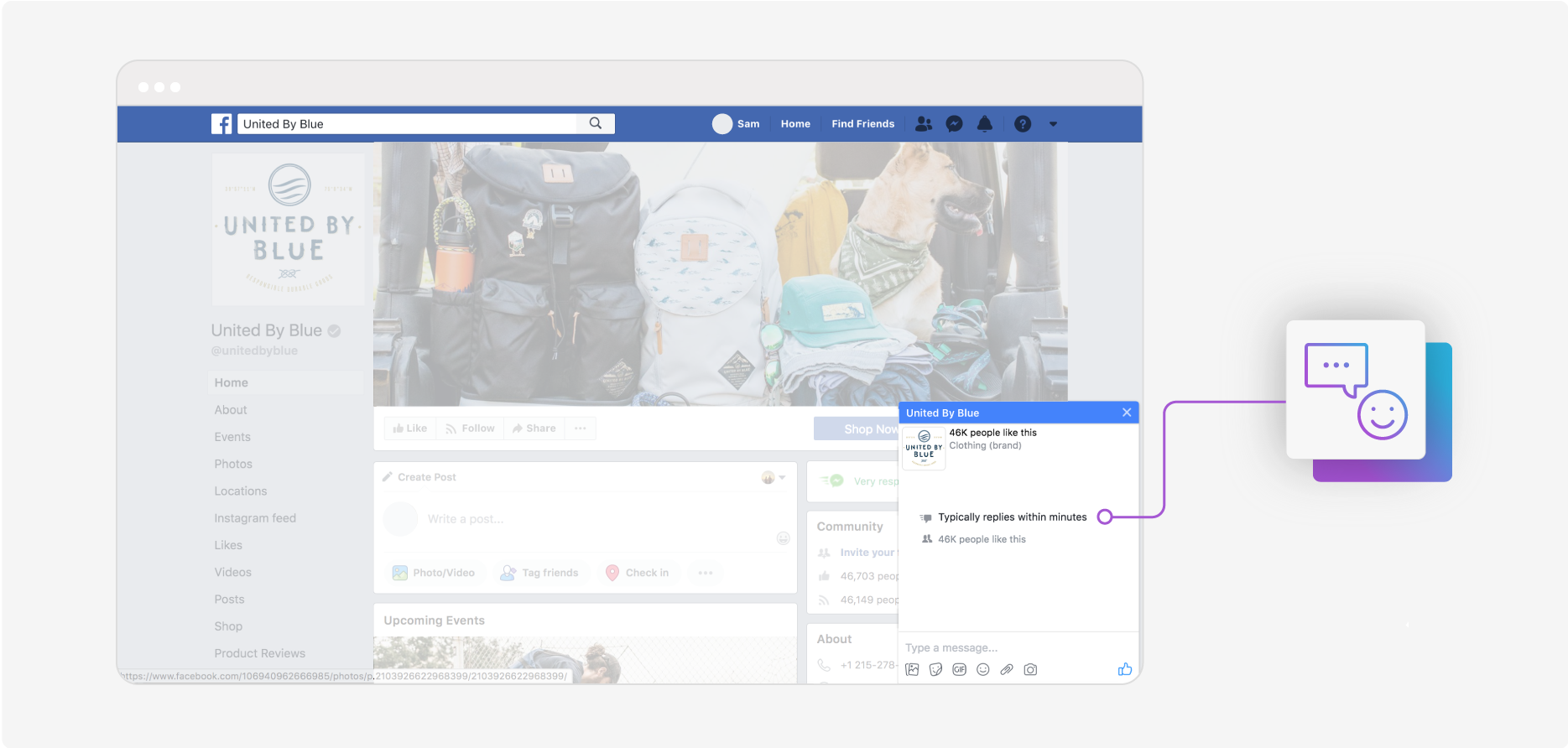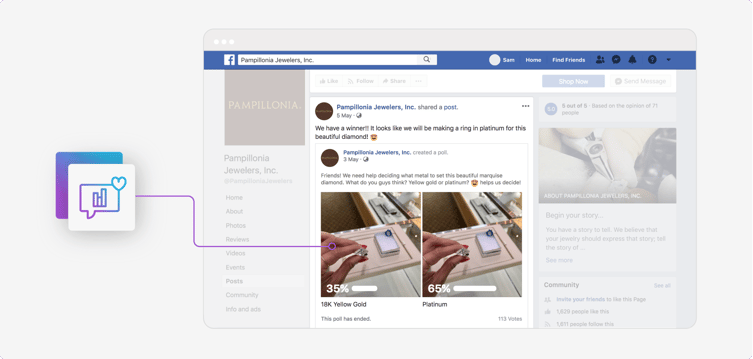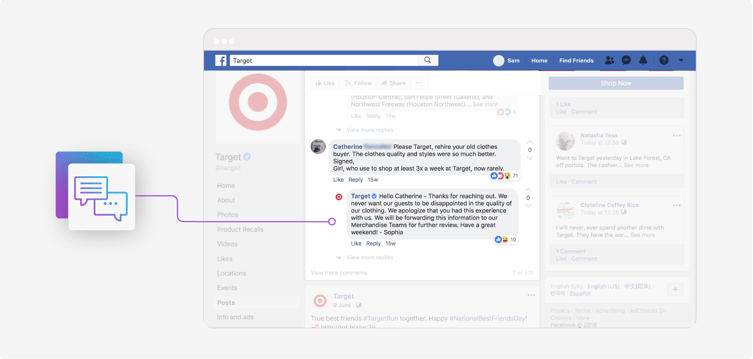
The Definitive Guide to Collecting, Measuring,
and Acting on Customer Feedback
Collecting customer feedback is crucial for your retail business. For starters, it can help you gauge how customers are responding to your brand and products, it can also help you to gather insights on your customers' opinions and develop actionable changes to improve your business.
Your customers provide feedback through a variety of ways, some through more defined channels, like reviews and surveys, and others less so, such as one-on-one interactions.
Let’s take a look at different types of customer feedback, why it’s important, and how you can use it to grow your business.
The importance of customer feedback
Customer feedback is important because it’s one of the best ways to understand your customers' shopping experience and perception of your brand. You can use it to identify what you’re doing well and where you have room to improve.
Beyond learning about your business, customer feedback can provide value in other ways. Public customer feedback, such as product reviews and social media comments can boost your image, improve SEO, and drive customer acquisition.
One brightlocal survey found that 91% of people regularly read online reviews – that’s a lot of potential customers. Plus, 84% trust online reviews as much as friends’ recommendations. In other words, feedback is social proof and can highlight things about your business to other customers. Plus, you can strengthen relationships with existing customers when you respond to their feedback.
Types of customer feedback methods
Now that we’ve established the value of collecting customer feedback let’s dive into the ways that you can gather comments and reviews from customers.
Live chat
Live chat is when customers can communicate in real-time, often via a chat box or some other messaging service, like Facebook Messenger. This is typically placed on your website, and you can also see it on many retailers’ Facebook pages.
United By Blue gives customers the opportunity to live-chat with United By Blue staff on their Facebook Business page and website.

One study found that cell phone customers who used live chat as a customer feedback channel have the highest overall customer satisfaction. Shoppers benefit from live chat because it’s instant support, and it offers an intimate interaction with customers.
For retailers, after collecting data about your customers, you can personalize interactions based on their past behavior. Using that data, you can leverage customer feedback collection via live chat to also drive sales.
One alternative from live chat run by customer service reps is to use chatbots. Chatbots can manage chat sessions with automated responses selected from a variety of pre-established messages; this reduces the amount of time your employees or support team needs to spend responding to common questions. Once the customer’s feedback gets to a place outside the norm, a real person can jump into the conversation to manage and respond to the feedback in real-time.
Quick tip: When interacting with customers via live chat, you’ll want to make sure your voice and tone are on-brand. Generally speaking, keep it light and friendly but professional. Post-chat, send an automated follow-up email with a summary or survey to ask about their experience (more on that feedback method later).
Customer Feedback Surveys
A survey is when you poll your customers to ask about their experience in your store or with your product(s). The survey is a question or set of questions that may be multiple choice, 'select all that apply', open-ended or fill-in-the-blank. Surveys may or may not be anonymous, depending on how you administer them or if respondents choose to share identifying information.
Sending surveys directly to your customers has several benefits, including:
More control over who can send feedback – Since you’re sending surveys to a list that you own (i.e., email subscribers, loyalty program members, existing customers, etc.), you’re in control over who can provide feedback. This makes it easier to review the answers of your respondents, and you’re more likely to receive meaningful responses, compared to a public or social media poll.
Private comments – The responses you get out of these surveys will be for your (and your team’s) eyes only, so any negative comments or complaints can be resolved privately.
Easier access to metrics and trends – Direct customer surveys can minimize the noise (e.g., spam, irrelevant or offensive comments, etc.) that often come with public polls, so surfacing insights and trends is much easier. Most survey solutions can also collect metrics and create graphs for you so that you can review and measure results more efficiently.
Automated surveys are a great customer feedback tool, as they can be triggered by certain events, for example, you can set up an automated survey to be sent to customers after they made a purchase, like this one from Prodermal:
Although the purchase was from their eCommerce site, they could also take the same approach for in-store purchases. Note: you’ll need to collect email addresses at the Point-of-Sale if you want to execute this particular customer feedback tactic.
You can also send a mass survey to your entire customer base or email list and use the quantitative data to identify trends. Remember to keep your questions clear and unbiased.
To encourage survey completion, keep it short. There is no hard rule on the ideal number of questions; it depends on your user base. Start with anywhere between three and ten questions (depending on their complexity) or run an A/B test with two versions of the survey to find what your sweet spot might be.
Looking to distribute a long survey, or having trouble getting responses? Incentivize customers to complete the survey, giving them the extra push to participate.
Polls
A poll is essentially a mini-survey, typically consisting of a single multiple-choice question. You can execute a poll to collect customer feedback both online and in-store. Polls also usually have fewer answers than a multiple-choice survey question; you’ll probably want to keep yours to four answers or fewer.
Retailers can use polls to determine if they should offer a particular service, size, product, or color. Consumers like polls because they’re easy to fill out and don’t take very long, meanwhile retailers yield substantial data.
Pampillonia Jewelers conducted a poll on their Facebook page asking users to tell them which stone to use in a piece of jewelry they were creating. Not only did this provide customer feedback by informing the jeweler on which style most resonates with their customers, but it also helped customers to become involved and feel like they're a part of the process.

Your poll should ask just one or two questions, with the number of answers limited. Too many choices can overwhelm a participant and might not produce useful data.
When adding a poll via Facebook, as many brands do, disable the ‘add choice’ option, or customers may abuse the privilege and skew your data. Set your poll to run for a specific amount of time and when you’ve collected the results, analyze them and share them with your audience.
Product reviews
With so many products available for sale online and in stores, customers sometimes need help picking which one is best – here’s where product reviews come into play. Product reviews are customer testimonials about your product – they inspire trust because they’re reliable social proof. 84% of consumers trust reviews as much as personal recommendations.
Regardless of what you sell, you can use product reviews as a form of marketing for your store – it’s user-generated content that you can repurpose. Plus, it helps boost SEO. Customers may also use reviews to mention a feature of your product they like or dislike, which gives you an idea of how you can better meet the demands of your market.
Make it easy for customers to leave reviews. Many website builders have apps that you can easily install to accommodate this.
Train sales associates to remind customers to leave a review after they’ve had a chance to enjoy their purchase. You can also set up email automation to send a friendly post-purchase nudge. If, after this, you’re still not getting enough reviews, you may want to offer an incentive, such as a coupon for your products or the chance to win a gift card.
30% of consumers believe it’s crucial for brands to respond to reviews, and nearly half of customers who leave a negative review expect responses within a week. Ignoring the review communicates that you don’t care, whereas responding shows that you’re listening.
A negative review isn’t the end of the world, either. As long as you’re gracious with your responses, your customers will appreciate the transparency you offered, and again, the negative comments might shine a light on something you didn’t consider before.
Online review sites
Your website and social media channels aren’t the only places where customers can review your brand. Third-party review websites are another valuable source of customer feedback.
Consider this: consumers read an average of seven reviews before trusting a business. Yelp, Facebook, and Google Reviews are among the most popular online review websites, and they’re also the most trusted by local customers.
Start by claiming your review pages on the following review sites, here are some handy links to help you get started:
The same rules regarding engagement with website or product reviews apply here: respond to them and let customers know you appreciate their feedback. If you receive a negative review and don't write a response, you may give customers the impression that you don’t care about their viewpoint.
Important: Don’t write fake reviews for your business or hire a third party to do so. Customers will be able to spot this a mile away, and it’s not the most ethical (or valid) way to receive feedback.
Social media and online community
90% of shoppers use social media to assist in making shopping decisions. Your customers are out there telling you what they think of your product and store, so be sure you don’t ignore this valuable feedback. Social media is also a great way to get user-generated content such as reviews you can share with your followers, so get on there and start looking out for your brand.
There are a few different ways you can use social media to get customer feedback about your store and products:
Social media reviews: Facebook business pages have the option to turn customer reviews on or off. Facebook users can use the platform to give a star rating and leave comments about their experience with your brand. This is probably the most straightforward form of customer feedback via social. Here’s an example from Ron Jon Surf Shop, which has Facebook reviews turned on.
Social media engagement metrics: looking at the engagement data for your social media profiles will give a high-level overview of customer feedback. These metrics may include a number of followers, likes, comments, shares, and retweets.
If you notice followers growing over time, you can look at this as an indirect form of customer feedback that they like what you’re doing and they want to see more. If followers decline, maybe there’s an issue with customer retention, or your social media strategy needs to be adjusted.
You can also take a proactive approach to leveraging customer feedback and gathering engagement metrics. How? Maybe you post a picture of the purple lipstick you stock this Tuesday, and next Tuesday you post a similar picture of your red lipstick. Seeing which post had more engagement could tell you which product is more popular among your social media followers.
One-on-one social media interactions: customers also provide feedback through private messages (DMs) on social media. These direct, one-on-one interactions are chock full of specific, qualitative insights. One example of how you can use these results is, perhaps you ask your social media team to prepare a weekly or monthly report detailing all the customer feedback they receive so you can regularly update your social media strategy. You can even develop a rapport with these customers and ask what they think of your adjustments.
Social listening: customer feedback on social media can happen on pages outside of your own. Seeing what people are saying about your brand/products on their own pages (or even competitors’ pages) can give you information that they may not have shared with your directly.
Usability tests
Have you ever considered how easy it is to use your eCommerce website? Your customers may find your site clunky or hard to use, and you could have no knowledge of this. Usability testing tools show you how real visitors are interacting with your site by capturing video, heat maps of popular areas, and audio of their movements. These tests determine how easy it is to navigate your website and may be performed online or in person.
Here are some resources you can look into to conduct usability tests as a form of customer feedback:
Accurately understanding how your customers are using your website is vital. Baymard conducted a usability review of Walmart’s website, examining the checkout process, on-site search, and product page design.
When faced with high cart abandonment rates, fashion brand ASOS hired a usability expert to determine the cause. After examining the current checkout, they implemented a more conversion-oriented purchase process – the change reduced their abandonment rate by 50%.
Test often; don’t test just once and call it a day. Your business and customers evolve, and so should your website. Avoid testing random people too; you’ll want representatives of your target market to test your website. Some questions to ask your testers:
- How easy is the checkout process?
- Can users easily locate your store hours and location?
- Will users be able to use any available coupon codes?
- Is the site loading quickly?
- Are images broken?
How to respond to customer feedback
Once your business receives feedback, it’s best to respond to it as soon as possible. Other customers may see the feedback on social media and your lack of response indicates that your business is dismissive toward unhappy customers. Even if feedback is positive, it’s important to show you’re paying attention and that you engage.
Here are some best practices for responding to feedback:
Acknowledge the customer and address their concerns
Always acknowledge your customer’s point-of-view – thanking them for sharing their experience is a good route to go. But remember to avoid copy-and-pasting a generic “Thanks for your review!” Instead, personalize it: “That sweater is a favorite among our customers! We’re glad you love it too!” or “We agree, that piece is beautiful. Thanks for sharing!”
If the feedback is negative, address the issue head-on. Rather than a simple “We’re sorry for your experience”, tell customers what you’re doing to address the issue.
Target regularly receives customer feedback and still finds time to respond to individual comments, even though the well-known brand has tons of engagement on all of its social media channels.

While negative feedback may seem like a personal attack, it’s important to resist jumping into defense mode. Avoid responding negatively, or you may facilitate a negative image of your brand. Phrases like “your opinion” or “this is why you’re wrong” – or even insulting customers for their feedback – shouldn’t be in your response. Even if they’re trolling, it’s best to take the high road!
While the Target customer above was upset about the quality of the clothing, the social media representative professionally addressed the complaint:
- Thanked them for sharing their view and addressed the shopper by name
- Apologized for their experience with the clothing selection
- Acknowledged customer happiness is their concern
- Forwarded the complaint and suggestion to the appropriate department to take action
- Personalized their response with their name and concluded with a pleasant send-off
Offer compensation through coupons, credits, or rewards
Depending on the situation, consider taking things a step further offering to compensate for their trouble (or to thank them for the great feedback). You can do this through:
- Coupons
- Account credits
- Rewards or points (if you have a loyalty program)
The folks at Shopify give this great example from Zappos, where they offer a $50 coupon to make up for an order delay.
See if you can do something similar for your customers. Why not email dissatisfied shoppers with a coupon that they can apply to their next purchase? Or if you’re like Zappos, who are dealing with public complaints on social media, alleviate the customer’s concerns in the comments section then send them a coupon privately.
Measuring customer happiness
A happy customer is a satisfied and loyal customer – these customers are vital to your business. It’s not enough to think your customers are happy; you should measure it through customer feedback.
Here are some key metrics to look at when measuring customer happiness for your store:
Customer Satisfaction Score
Your Customer Satisfaction Score (CSAT) is a measurement of how content a customer is with a product, service, or company. The scoring is based on a series of questions where a customer ranks their satisfaction according to a presented scale.
To calculate your CSAT, ask questions like ‘how would you rate the service you received?’ and ‘how would you rate your overall satisfaction?’. Respondents choose from a set of scores, such as ‘good,’ ‘fair,’ ‘very satisfied,’ etc., or a numerical ranking system.
Here’s how Torrid uses questions to calculate their CSAT:
When you run a CSAT survey, you need to set a goal and then evaluate the data to see if you reached the goal – if you didn’t, you may need to make some adjustments.
Churn rate
Your churn rate is the number of customers who stop doing business with your store. The goal is to get your churn rate to be as low as possible. Churn rate tells you plenty about your customers’ happiness. While churn rate is largely applied to subscription services, you can still calculate it with an easy formula:
Churn rate = customers who have left / customers you still have
As a benchmark, many experts recommend having an annual churn rate of 5-7%. If the churn rate in your business falls above that range, then you should consider implementing re-engagement initiatives such as:
- Sending recovery cart emails – get in touch with customers who added items to their cart but left your site without completing checkout.
- Implementing a “win-back” email flow – send automated messages to shoppers who haven’t stopped by in a while.
- Collecting customer feedback – gather shopper feedback (and address them) to improve customer satisfaction.
Social media metrics
Key social media metrics to look at to determine customer happiness include:
- Average review rating (if you have this turned on)
- Positive reviews vs. negative reviews
- Likes, comments, shares, and retweets of your posts
- Followers
- Follower growth
- Mentions
It’s important to look at these metrics over time to see how they’re changing. You’ll also want to look at qualitative data, such as the content of customer reviews, comments, and direct messages, to uncover any trending feedback.
There are a number of social media tools that will tell you sentiment about your brand, and whether the social chatter about you is positive or negative. Here are some tools that you can use to measure sentiment:
Acting on customer feedback
As we’ve noted before, responding to customer feedback is absolutely essential. It lets customers know you value their opinion, and in public-facing scenarios, this enhances the perception of your brand. But there are other things you can do with customer feedback to propel your business forward.
Conversion copywriter Momoko Price once gave a presentation at CXL Live where she called people ‘askholes.’ An askhole is someone who asks for feedback and does nothing with it. “Don’t be an askhole,” she advised.
The point she was making was that businesses need to understand what the feedback is telling them, and then act accordingly – especially during a time where a data-driven approach is a pillar of sustainable retail success. Failure to do so won’t help grow your business and could leave it stagnant. Worst of all, if you have feedback from unhappy customers and it goes unaddressed, they’re not going to shop with you again.
Look for trends. If a group of customers is giving similar feedback, take a look at how you can address their concerns. Let’s say customers are complaining that the sizing is off for the shorts you sell; perhaps you go to the product team and see if they can adjust the sizing, or maybe the web team can enhance product pages to make note of sizing discrepancies while in-store associates will encourage try-ons.
Or maybe customers repeatedly say they love your iPhone cases but want to purchase a Google Pixel version. Calculate your margins to see it it’s feasible. Can you buy the Pixel cases from your existing supplier or do you need to look for a new one? What about the design, can you easily repurpose the iPhone case design? Will it require new software or printing capabilities? Remember to look at the customers who requested the Pixel cases – what was their average order size? How frequently do they shop with your brand?
Implementing customer feedback methods in your business
If you don’t currently use customer feedback in your business, it’s time to start. The ways profiled here are easy to implement. Begin canvassing social media to see what your customers are saying about you and to you. Be direct but not badgering with your feedback collection. Surveys can be emailed to customers after they complete a purchase or printed on your store’s receipts. Your customers might be enticed to respond to feedback requests if they know they can get something from their actions, so considering holding a drawing or giving away a coupon for reviews.
What methods have you used to gain valuable feedback for your business?
The bottom line
Customer feedback is one of the most valuable things a business can have. Aside from giving you rich insights that you can use to improve, shopper feedback can also play a big role in marketing and customer acquisition. As we mentioned earlier, you can leverage customer ratings, reviews, and praises to improve brand perception and even boost your SEO rankings.
For these reasons, you need to make customer feedback management a priority in your business. Look into your existing processes for handling shopper praise and complaints. Are you collecting feedback regularly? How are you measuring feedback? Are you using ratings and reviews in your marketing?
Use these questions to identify what you need to work on then go from there.

